You are on CGS' Legacy Site.
Thank you for visiting CGS! You are currently using CGS' legacy site, which is no longer supported. For up-to-date information, including publications purchasing and meeting information, please visit cgsnet.org.
General Content
Quality and accountability in US higher education depend on thoughtful assessments of undergraduate student learning. Faculty are expected to use assessment methods that enhance teaching and learning, yet few graduate students receive formal preparation in this area. With funding from the Teagle Foundation, CGS developed a project to explore the potential of Preparing Future Faculty (PFF) and similar programs to fill this gap. This report provides data and insights gleaned from assessment experts, graduate deans, and graduate students about opportunities to integrate preparation in learning assessment into professional development programs for graduate students.
Member Discount Pricing
Starting from: 10 pieces $12.75
Starting from: 25 pieces $11.00
Starting from: 50 pieces $10.00
Starting from: 100 pieces $8.00
Starting from: 200 pieces $6.00
The rapid expansion and increasing diversity of the PSM from a handful of programs a little more than a decade ago to almost 240 PSM programs today point to a distinct area of growth in master's education that is responsive to the needs of students and employers. This monograph is intended to serve as a guide for those who are considering establishing PSM programs at their institutions. We provide background and context and discuss feasibility analysis, program development and operation, formal PSM affiliation, and program sustainability. This monograph is a major rewrite of the earlier monograph, Professional Master's Education (2006).
Member Discount Pricing
Starting from: 10 pieces $29.70
Starting from: 25 pieces $26.24
Starting from: 50 pieces $21.00
Starting from: 100 pieces $17.50
Starting from: 200 pieces $14.00
(Reprinted from the May 2012 issue of GradEdge)
Graduate deans report that their top pressing issues in 2012 are about recruitment, admissions, and enrollment management, according to the Council of Graduate Schools’ (CGS) annual Pressing Issues Survey. Each year, CGS asks graduate deans at member institutions to identify the three most important or “pressing” issues or challenges they currently face. The findings from this Pressing Issues Survey inform CGS about the concerns of graduate deans and help to shape sessions at Summer Workshops, Annual Meetings, and other forums, as well as future best practices projects. The survey has been conducted annually as part of the CGS International Graduate Admissions Survey, Phase I: Applications since 2004 and through the CGS membership survey and other surveys in prior years.
The 2012 Phase I survey was sent to the 500 U.S. colleges and universities that were members of CGS as of January 2012. A total of 242 institutions responded to the survey, for a response rate of 48% (Bell, 2012). About 91% (221) of the Phase I survey respondents wrote in one or more pressing issues in response to this open-ended question, and the analyses below are limited to these 221 respondents. They included 147 doctoral institutions, 58 master’s-focused institutions, and 16 institutions classified as baccalaureate or specialized in the 2010 basic Carnegie Classifications. Sixty-nine private, not-for-profit institutions responded to the Pressing Issues Survey, along with 152 public institutions. By geographic region, 60 of the responding institutions were in the Midwest, 49 were in the Northeast, 33 in the West, and 79 in the South. Responses to the Pressing Issues Survey were coded into broad categories. Since respondents were able to write in up to three pressing issues, the percentages sum to more than 100%.
Pressing Issues in 2012
The top pressing issue identified by graduate deans was recruitment, admissions, and enrollment management, mentioned by more than half (58%) of all respondents (see Table 1). Within this category, respondents mentioned managing declining or growing enrollments, competition for prospective graduate students, challenges in attracting a diverse applicant pool, challenges in recruiting international students, and recruiting quality graduate students, among other concerns. Respondents from master’s and specialized institutions were more likely to mention recruitment, admissions, and enrollment management than graduate deans from doctoral institutions (68% vs. 54%), and respondents from private, not-for-profit institutions were more likely to indicate that this was a pressing issue than those at public institutions (65% vs. 55%).
Graduate student financial support was the second most commonly mentioned pressing issue, with half (50%) of all respondents saying this was a concern. This category includes health insurance for graduate students, as well as direct support through assistantships, fellowships, etc. Graduate deans from doctoral institutions were more likely than those from master’s and specialized institutions to indicate that graduate student financial support was a concern (53% vs. 45%). Respondents from public institutions were more likely to note graduate student financial support as a pressing issue than respondents at private, not-for-profit institutions (53% vs. 45%).
Graduate program financing, dealing with budget cuts, and issues related to state economies and the national economy ranked third (36%). Respondents from doctoral institutions and master’s and specialized institutions were nearly equally likely to mention this issue, as were respondents from public institutions and private, not-for-profit institutions.
General management and administration issues ranked as the fourth most pressing issue this year (28%). Within this category, respondents mentioned implementing new technology systems, changes to policies and procedures, and changes to the structure of the graduate school, among other concerns. Respondents from doctoral institutions were more likely to mention general management and administration issues than graduate deans from master’s and specialized institutions (30% vs. 24%), and respondents from private, not-for-profit institutions were more likely to indicate that this was a pressing issue than those at public institutions (32% vs. 26%).
The percentages of respondents who mentioned the remaining pressing issues are shown in Table 1. Student support and services (24%) includes advising and mentoring, professional development for graduate students, mental health counseling, career advice, and job placement assistance, among other concerns. All issues related to program quality; the evaluation, assessment, or review of graduate programs; accreditation; and student learning outcomes were grouped together as program quality, evaluation, assessment, and review (16%). The category of faculty and staff issues (11%) mainly includes responses about the challenges of dealing with faculty and staff shortages, primarily due to budget cuts. Issues surrounding retention, completion, attrition, and time-to-degree (11%) are also grouped together, as are responses related to developing or eliminating programs (9%). The category of leadership and advocacy (7%) includes responses related to promoting graduate education and communicating the value of graduate education to internal and external stakeholders, among other related issues. Finally, all responses related to program delivery, including the delivery of online, distance, interdisciplinary, and joint and dual programs are grouped as program delivery (7%).

Pressing Issues by Carnegie Classification and Institutional Control
The rank order of the top three pressing issues was the same for respondents from doctoral institutions as it was for respondents from master’s and specialized institutions (see Table 1). In both cases recruitment, admissions, and enrollment management was the top issue (54% and 68%, respectively), graduate student financial support was ranked second (53% and 45%, respectively), and graduate program financing, dealing with budget cuts, and issues related to the economy ranked third (37% and 35%, respectively). Respondents from doctoral institutions were more likely than respondents from master’s and specialized institutions to mention student support and services (31% vs. 12%), but they were less likely to mention faculty and staff issues (7% vs. 18%).
The findings for respondents from public institutions and private, not-for-profit institutions also mirrored the overall findings, with recruitment, admissions, and enrollment management; graduate student financial support; and graduate program financing, dealing with budget cuts, and issues related to the economy as the first, second, and third most pressing issues, respectively (see Table 1). However, respondents at private, not-for-profit institutions were more likely than those at public institutions to indicate that recruitment, admissions, and enrollment management was a pressing issue (65% vs. 55%) and that student support and services was a concern (32% vs. 21%). In contrast, respondents at public institutions were more likely than those at private, not-for-profit institutions to cite graduate student financial support as a pressing issue (53% vs. 45%).
Pressing Issues by Geographic Region
Recruitment, admissions, and enrollment management was the top pressing issue identified by graduate deans at institutions located in all four regions of the United States (see Table 2). The percentage of respondents indicating this area as a pressing issue ranged from a low of 53% of respondents in the South to a high of 67% of respondents in the West. Graduate student financial support was the second most pressing issue across all four regions, with about half of all respondents in each geographic area indicating that this was a concern. Graduate program financing/budget/economy was the third most pressing issue for respondents from the Midwest, West, and South, while general management and administration issues ranked third for respondents from the Northeast. Respondents from the Northeast were also most likely to mention issues related to student support and services.

Historical Comparison of Pressing Issues
Articles in previous years about the Pressing Issues Survey have provided an examination of the changes in pressing issues over time. Over the past several years, however, there have been variations in coding among researchers, as well as variations in the broad categories used to group issues, meaning that such an examination of changes over time is inexact. Rather than presenting rankings of pressing issues categories over time, it is better to simply touch on the issues that remain among the top concerns of graduate deans each year.
Two broad topics in particular have been mentioned frequently by graduate deans over the past several years: graduate student financial support and recruitment, admissions, and enrollment management. In most recent years, these have been among the two most pressing issues faced by graduate deans. Issues related to graduate program financing, dealing with budget cuts, and the economy have also been mentioned frequently by graduate deans, particularly in the last four years. General management and administration issues have also been cited as concerns in recent years, but given the wide variety of issues that are typically grouped within this category, the specific challenges have varied from year to year.
Conclusion
The results of this year’s Pressing Issues Survey reveal that the majority of graduate deans view recruitment, admissions, and enrollment management as their top concern, as they face issues related to managing declining or growing enrollments, competition for prospective graduate students, and challenges in attracting a diverse applicant pool, among other concerns. They also remain concerned about graduate student financial support and about graduate program financing, dealing with budget cuts, and issues related to the economy. The latter is often reflected in other broad categories as well, with respondents mentioning concerns about the effect of budget cuts on other aspects of graduate education, including recruiting budgets, personnel, and program delivery. Overall, the results of the Pressing Issues Survey reveal the continued focus of graduate deans on recruiting, enrolling, and financially supporting high quality graduate students; on offering high quality graduate programs that produce graduates ready to meet the demands of the 21st century global economy; and on providing students with the necessary support to ensure their successful completion.
By Nathan E. Bell, Director, Research and Policy Analysis, Council of Graduate Schools
References:
Bell, N.E. (2012). Findings from the 2012 CGS International Graduate Admissions Survey, Phase I: Applications. Washington, DC: Council of Graduate Schools.
In response to the Office of Science and Technology Policy (OSTP) request for information, the Council of Graduate Schools (CGS) was pleased to provide input to the Administration’s National Bioeconomy Blueprint detailing steps to harness biological, research innovations to address challenges in health, food, energy and the environment.
CGS provides resources on a range of topics for current and prospective graduate students.
Publications Access
As a benefit of institutional membership, online access to CGS publications is provided to students at member institutions.
(Is my institution a CGS member?)
To create a new user account for publications access, complete this form. If you already have a user account for cgsnet.org, login with your username (i.e., your institutional email address) and password for access to the CGS Member Library.
By creating a user account, you agree to the Terms of Use for Electronic Publications.
Hard copies of CGS publications are also available for purchase. Read more about the CGS Member Library.
Resolution Regarding Graduate Scholars, Fellows, Trainees, and Assistants
In 2014, the Council of Graduate Schools reaffirmed its support of what is known as the “April 15th Resolution,” which concerns the obligations of graduate institutions and prospective graduate students regarding offers and acceptances of financial support. View the Resolution. Resolution renewed October 2019.
The results of the latest International Graduate Admissions Survey show that applications increased 9% between 2011 and 2012.
To learn more about this report, please click here.
(Reprinted from the April 2012 issue of GradEdge)
The Ronald E. McNair Post-Baccalaureate Achievement Program, also known as the McNair Scholars Program, is the largest federal effort aimed at preparing low-income, first-generation in college and minority undergraduates to pursue doctoral studies. The McNair Scholars Program is funded through the U.S. Department of Education’s TRIO programs and provides participants with research internships, faculty mentors, opportunities to present and publish results of their research, undergraduate teaching experience, and assistance with applying to and preparing for graduate school.
McNair Scholars represent a diverse pool of prospective graduate students, including students who are traditionally underrepresented at all levels of higher education. According to the U.S. Department of Education, about seven out of ten McNair Scholars (71%) are low-income and first-generation college students (U.S. Department of Education, 2007). In addition, seven out of ten McNair Scholars are underrepresented minorities. In 2004–05, the latest year for which data are available, about 43% of McNair Scholars were Black/African American, about 24% were Hispanic/Latino, and approximately 3% were American Indian/Alaska Native. That same year, more than two-thirds (68%) of all McNair Scholars were female, a percentage that has gradually increased over time, up from about 65% in 1997–98 (U.S. Department of Education, 2005; U.S. Department of Education, 2007).
While the Department of Education has reported on the demographic characteristics of McNair Scholars, to date the Department has not released any data on McNair Scholars by field of study. However, this information can be gleaned from the annual McNair Scholars Directory. Conducted under the auspices of the CGS/COE Joint McNair Committee, the McNair Scholars Directory is a collaborative effort of the Council of Graduate Schools and the Council for Opportunity in Education. The directory is designed to provide graduate schools with access to McNair Scholars who have expressed an interest in pursuing graduate studies in order to facilitate the recruitment of these highly talented individuals into graduate school. The directory contains records of recent graduates, seniors, and rising seniors, with McNair Scholars’ names, contact information, undergraduate majors, areas of interest for graduate study, and undergraduate research projects. More than four out of five (84%) McNair Scholars Programs provided information for the 2011–12 McNair Scholars directory; roughly 3,300 McNair Scholars are included in the Directory. (The password-protected Directory is available for download from COE’s website, http://www.coenet.us.)
Among the McNair Scholars included in the 2011–12 McNair Scholars Directory, two-thirds are enrolled in science, technology, engineering, and mathematics (STEM) fields at the undergraduate level (Council for Opportunity in Education, 2011). As shown in Figure 1, 30% are enrolled in science and engineering fields, and 37% are in social and behavioral sciences at the undergraduate level. About one in ten McNair Scholars are pursuing a degree in arts and humanities.
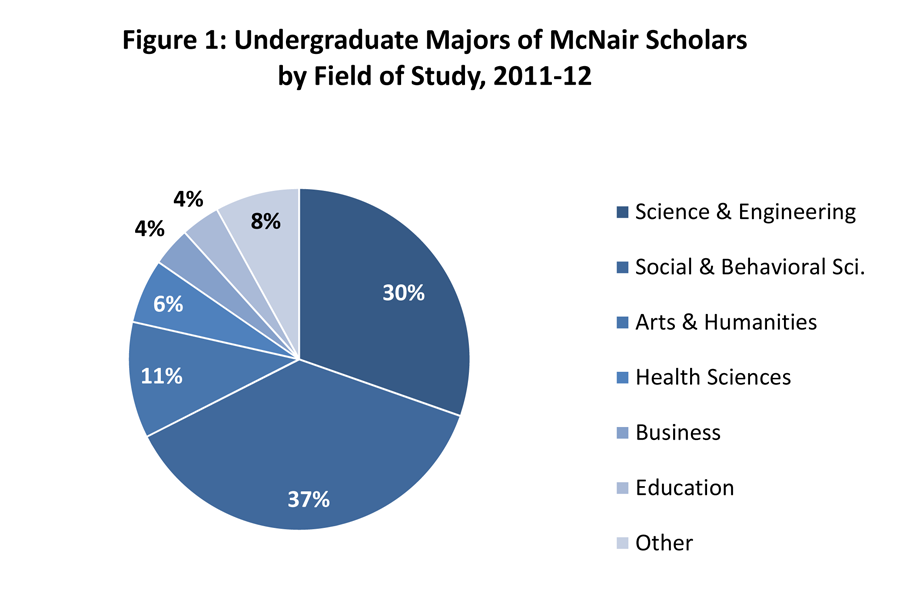
The enrollment of McNair Scholars by field of study differs substantially from overall undergraduate enrollment. While two-thirds of McNair Scholars are in STEM fields, only about three out of ten undergraduates at four-year institutions in the United States are majoring in STEM fields (including social sciences), indicating that McNair Scholars are more than twice as likely than all undergraduates to be pursuing a degree in STEM (Snyder & Dillow, 2011).
As shown in Figure 2, similar but slightly smaller percentages of the McNair Scholars included in the 2011–12 McNair Scholars Directory indicated that their primary area of interest for graduate study was in STEM (Council for Opportunity in Education, 2011). Some 28% of McNair Scholars intend to enroll in science and engineering at the graduate level, and one-third (34%) plan to pursue a graduate degree in social and behavioral sciences. Arts and humanities and health sciences each account for about one out of ten McNair Scholars.
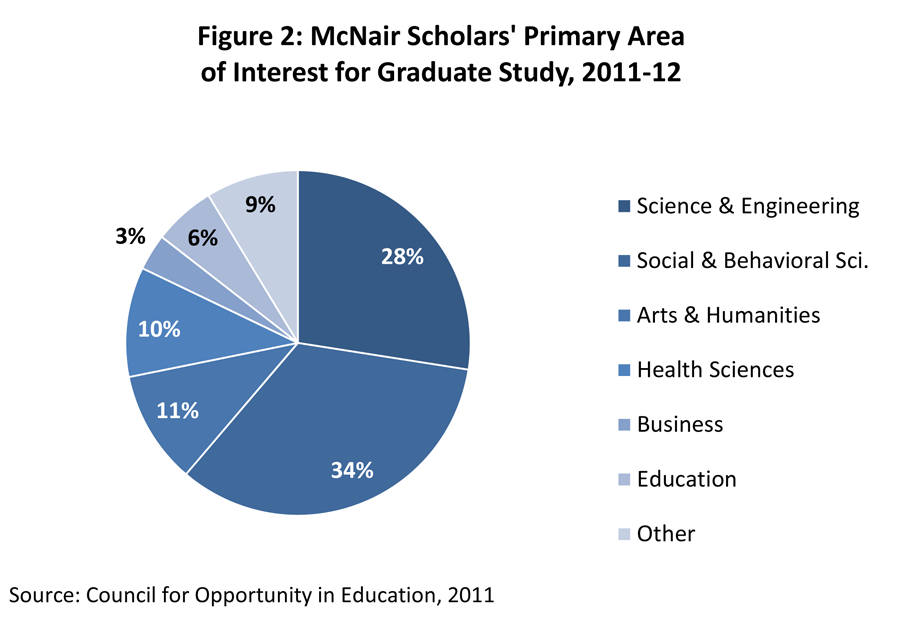
While the data on outcomes for McNair Scholars are incomplete, the available data do indicate that the bachelor’s degree attainment rate of McNair Scholars is very high. Among active McNair Scholars in 1997–98, 95% of these students completed their bachelor’s degree by 2001–02 (U.S. Department of Education, 2005). Overall at the bachelor’s level, only about 57% of all first-time, full-time students at four-year institutions complete a bachelor’s degree within six years (Knapp, Kelly-Reid, & Ginder, 2011). While there is not a direct comparison between these two statistics, it does illustrate the high success rate of McNair Scholars in completing their undergraduate degrees.
The available data also suggest that McNair Scholars have high graduate enrollment rates. Among McNair Scholars who graduated in 2006–07, more than one-half (53%) were enrolled in graduate school in 2007–08, the academic year immediately after receipt of the baccalaureate (U.S. Department of Education, 2012). The outcomes data from earlier cohorts suggest that even more of the 2006–07 McNair Scholars enrolled in graduate school two or more years after receipt of the baccalaureate (U.S. Department of Education, 2005). There is also some evidence to suggest that McNair Scholars are more likely to enroll in graduate school in the year after graduation than their demographically similar non-McNair peers. However, this analysis is limited by some missing and invalid data, and in some cases from inconsistencies in the way that questions were asked from year to year (U.S. Department of Education, 2005).
Discussion
Overall, McNair Scholars are more likely to be from populations that are underrepresented in graduate education and are likely to be majoring in STEM fields. Additionally, McNair Scholars are receiving the preparation to enable them to succeed at the graduate level, making this population of talented students an important focus for graduate school recruitment. As stated in the 2010 report, The Path Forward, the global competitiveness of the United States and our capacity for innovation hinge fundamentally on our ability to produce sufficient numbers of graduate degree-holders to meet future workforce demands, and key to accomplishing this is increasing the numbers of underrepresented students entering, and completing, graduate studies (Wendler et al., 2010). The goal of the McNair Scholars program is to do just that.
Despite having some data about the characteristics of McNair Scholars, their undergraduate degree attainment rates, and their immediate graduate school enrollment rates, an examination of outcomes for McNair Scholars is constrained by a lack of sufficient data. We know nothing about the outcomes for McNair Scholars who completed their undergraduate degrees within the past five years, even though this information is reported annually by the McNair Scholars Programs to the U.S. Department of Education. For the earlier cohorts, we lack sufficient data to reveal the eventual doctoral degree attainment rates for McNair Scholars, as well as other types of advanced degrees they may have earned, such as master’s degrees and first-professional degrees. These data, along with information on career outcomes, would provide a much more comprehensive picture of the impact of the McNair Scholars Program. A more robust, longer term study, including a study of a comparison group of low income, first generation undergraduates who did not participate in the McNair Scholars Program, would reveal more complete information about outcomes for McNair Scholars.
By Nathan E. Bell, Director, Research and Policy Analysis, Council of Graduate Schools
References:
Council for Opportunity in Education. (2011). 2011–2012 McNair Scholars Directory. Retrieved from http://www.coenet.us.
Knapp, L.G., Kelly-Reid, J.E., and Ginder, S.A. (2011). Enrollment in Postsecondary Institutions, Fall 2009; Graduation Rates, 2003 & 2006 Cohorts; and Financial Statistics, Fiscal Year 2009 (NCES 2011-230). Washington, DC: U.S. Department of Education.
Snyder, T.D., and Dillow, S.A. (2011). Digest of Education Statistics 2010. Washington, DC: U.S. Department of Education.
U.S. Department of Education. (2005). A Profile of the Ronald E. McNair Postbaccalaureate Achievement Program: 1997–1998 Through 2001–2002. Washington, DC: Author.
U.S. Department of Education. (2007). Ronald E. McNair Postbaccalaureate Achievement Program: 2002–05 Facts and Figures at a Glance. Washington, DC: Author.
U.S. Department of Education. (2012). Ronald E. McNair Postbaccalaureate Achievement Program Annual Performance Reports, 2006–07 and 2007–08. Retrieved from http://www2.ed.gov/programs/triomcnair/mcnair-cy-0607.pdf
Wendler, C., Bridgeman, B., Cline, F., Millett, C., Rock, J., Bell, N., and McAllister, P. (2010). The Path Forward: The Future of Graduate Education in the United States. Princeton, NJ: Educational Testing Service.
(Reprinted from the March 2012 issue of GradEdge)
Individuals with graduate degrees will be in growing demand over the next several years, according to new employment projections from the Bureau of Labor Statistics (BLS). These projections are part of BLS’ biennial examination of expected long-term changes in employment by occupation, industry, level of education, and demographics. The data provide a comprehensive outlook of employment in the United States through 2020.
Employment Projections by Educational Attainment
According to BLS’ projections, the number of jobs typically requiring a doctorate or a professional degree for entry is projected to increase by 20% between 2010 and 2020, and the number typically requiring a master’s degree for entry is expected to grow by 22% (Sommers & Franklin, 2012). These rates of increase exceed the overall 14% growth projected for all occupations between 2010 and 2020 and also exceed the gains expected for individuals with lower levels of educational attainment. As shown in Figure 1, the number of jobs typically requiring a bachelor’s degree for entry is expected to increase by 17% between 2010 and 2020, and the number of jobs typically requiring an associate’s degree for entry is expected to increase by 18%.
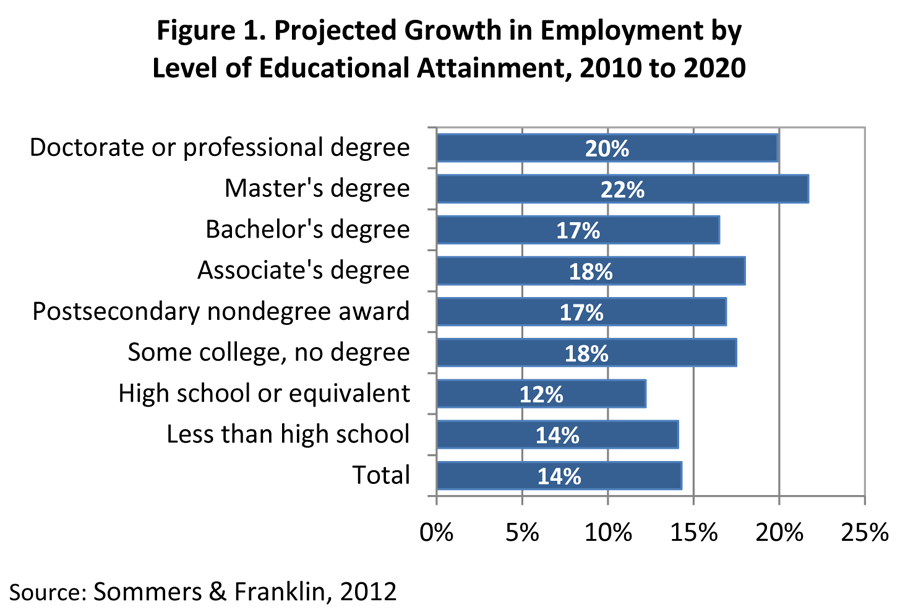
Overall, employment in the United States is projected to grow from nearly 143.1 million jobs in 2010 to more than 163.5 million in 2020, an increase of nearly 20.5 million jobs (Sommers & Franklin, 2012). About 877,000 of these new jobs will typically require a doctorate or a professional degree for entry, and about 431,000 will typically require a master’s degree for entry.
In addition to the new jobs that are expected to be created between 2010 and 2020, job openings will also occur due to replacement needs resulting from current workers who retire, leave the labor force, or move to other occupations. When replacement needs and job growth are taken into account, a total of about 2.6 million job openings typically requiring an advanced degree for entry are expected to occur between 2010 and 2020 (Sommers & Franklin, 2012). Of these jobs, 1.7 million will typically require a doctorate or a professional degree for entry, and 900,000 will typically require a master’s degree for entry.
Employment Projections by Occupation
Between 2010 and 2020, many of the occupations in which employment is expected to grow rapidly will be in health care, personal services, and social services (Lockard & Wolf, 2012). Some of the occupations with the largest projected percentage growth in jobs typically do not require an advanced degree for entry, but six of these occupations typically do. Those occupations include marriage and family therapists, with a 41.2% projected increase in jobs between 2010 and 2020; physical therapists (37.7%); audiologists (36.8%); medical scientists (36.4%); mental health counselors (36.3%); and veterinarians (35.9%).
In addition to presenting data on the occupations with the largest projected percentage growth in jobs, BLS also lists occupations with the largest projected numeric growth in jobs. Postsecondary teachers made this list of the occupations with the largest projected numeric growth in jobs between 2010 and 2020, appearing at number 10 on the list, with an expected 17% increase, from about 1.8 million jobs in 2010 to 2.1 million in 2020. All of the other occupations with larger projected numeric growth in jobs typically require lower levels of educational attainment than a graduate degree.
Employment Projections by Industry Sector
The health care and social assistance sector is expected to be the leader in employment growth between 2010 and 2020, with an average projected annual gain of 3.0% (Henderson, 2012). Educational services and professional and business services are also expected to show strong growth in employment, with projected annual gains of 2.3% and 2.1%, respectively. Some industry sectors are expected to experience declines in employment between 2010 and 2020. Leading that list is the federal government, in which BLS projects that employment will decrease by about 1.3% annually on average, falling from nearly 3.0 million employees in 2010 to about 2.6 million in 2020, with much of this decline the result of a projected reduction in jobs at the postal service.
Employment Projections by Employee Demographics
Between 2010 and 2020, the U.S. labor force is projected to continue to age, in large part because the baby-boom generation will be 56 to 74 years old in 2020 (Toossi, 2012). Individuals 55 years of age and older are expected to account for about 25% of the civilian labor force in 2020, up from 20% in 2010 and just 13% in 2000. In contrast, individuals 25 to 54 years old are expected to account for 64% of the civilian labor force in 2020, down from 67% in 2010 and 71% in 2000.
The U.S. labor force will also become more diverse in the coming years, with a slight increase in the number of women in the labor force and a larger gain in the number of minorities (Toossi, 2012). Women are expected to account for 47% of the civilian labor force in 2020, a minimal increase from 46.7% in 2010 and 46.5% in 2000. As shown in Figure 2, Hispanics and Asians are expected to account for a larger share of the civilian labor force in 2020 than they do today, while the White, non-Hispanic share is projected to continue to decline. These changing demographics of the U.S. labor force reflect the rapidly growing Hispanic population in the United States.
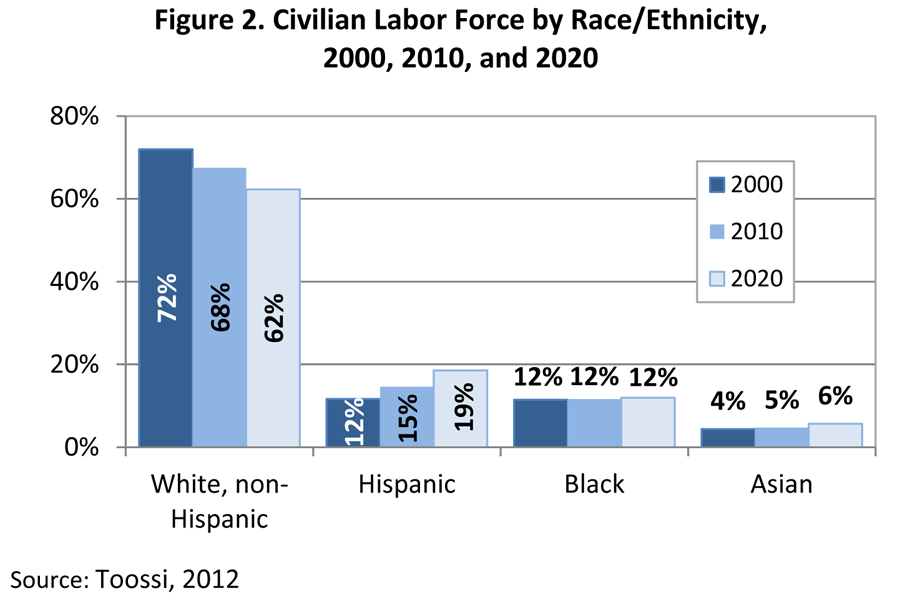
Discussion
The BLS data suggest robust growth in employment for individuals with graduate degrees, but the employment projections actually underestimate the number of graduate degree recipients in the labor force. BLS’ projections focus on the level of educational attainment that is typically required for entry into an occupation, even though many employees in that occupation may have more advanced degrees. Teachers and engineers are two prime examples of this. Both occupations are classified as typically requiring a bachelor’s degree for entry, even though many teachers and engineers hold graduate degrees. For example, 28% of civil engineers and 51% of secondary school teachers have a master’s degree, a doctorate, or a professional degree (Bureau of Labor Statistics, 2012). This means that while 2.6 million new and replacement jobs requiring an advanced degree for entry are expected between 2010 and 2020, many more individuals with graduate degrees will enter the labor force in the coming years.
The employment growth projected by BLS reflects the demands of an aging population as the baby-boom generation heads into retirement. Health-related occupations dominate the list of the fastest growing occupations, while projected growth in other occupations, such as postsecondary teachers, reflects the impending retirements of baby-boomers. As the labor market recovers from the recession and continues to grow over the coming years, BLS projects strong demand in employment opportunities for individuals with graduate degrees, good news indeed for today’s graduate students.
By Nathan E. Bell, Director, Research and Policy Analysis, Council of Graduate Schools
References:
Bureau of Labor Statistics. (2012). Educational attainment for workers 25 years and older by detailed occupation, 2009. Retrieved from http://www.bls.gov/emp/ep_table_111.htm
Henderson, R. (2012). Industry employment and output projections to 2020. Monthly Labor Review Online, 135(1), 65–83. Retrieved from http://www.bls.gov/opub/mlr/2012/01/
Lockard, C. B., & Wolf, M. (2012). Occupational employment projections to 2020. Monthly Labor Review Online, 135(1), 84–108. Retrieved from http://www.bls.gov/opub/mlr/2012/01/
Sommers, D., & Franklin, J. C. (2012). Overview of projections to 2020. Monthly Labor Review Online, 135(1), 3–20. Retrieved from http://www.bls.gov/opub/mlr/2012/01/
Toossi, M. (2012). Labor force projections to 2020: A more slowly growing workforce. Monthly Labor Review Online, 135(1), 43–64. Retrieved from http://www.bls.gov/opub/mlr/2012/01/
(Reprinted from the January/February 2012 issue of GradEdge)
For many students, the academic journey leading to a graduate degree starts with community college. These institutions provide access to higher education for students who in some cases may not yet even realize that a master’s degree or a doctorate is attainable. For other students, community colleges provide an affordable and/or a convenient means of earning college credit prior to enrolling, or even while enrolled, in a four-year institution.
In fall 2009, more than 7.5 million students were enrolled at two-year colleges in the United States (Snyder and Dillow, 2011). This figure reflects a rapid expansion in two-year college enrollment over the past decade, with an increase of more than one-third (34%) between 1999 and 2009. The majority (57%) of two-year college enrollees in fall 2009 were enrolled part-time.
Community colleges play an important role for students who are underrepresented in higher education. For example, two-year institutions enroll higher percentages of first generation college students than four-year institutions, as well as higher percentages of low socioeconomic status students and older students (Provasnik and Planty, 2008). These institutions also are important pathways to degree attainment for underrepresented minorities (African Americans, Hispanics, and Native Americans), since individuals from these racial/ethnic groups account for a higher percentage of the enrollees at two-year colleges than at four-year colleges. African Americans comprised 15% of the enrollees at two-year colleges in fall 2009, compared with 14% at four-year colleges. Hispanics comprised 17% of the enrollees at two-year colleges, compared with just 10% at four-year colleges, and Native Americans accounted for 1.2% of the enrollees at two-year colleges, compared with 0.9% at four-year colleges (Snyder and Dillow, 2011).
While two-year institutions serve higher percentages of underrepresented students, not all students attending these institutions do so with the intention of earning a degree. About 43% of two-year college attendees plan to complete an associate’s degree, and about 36% plan to transfer to a four-year institution (Provasnik and Planty, 2008). Many of the degree-seeking students, however, will fail to earn an associate’s degree or transfer to a four-year institution. The current degree completion rate at community colleges is just 28%, meaning that nearly three-quarters of all two-year college attendees fail to earn a certificate or a degree within 150% of the expected normal time to completion (Snyder and Dillow, 2011). And only about one in five students (21%) will transfer to a four-year institution within five years of enrolling at a community college (National Center for Education Statistics, 2011).
Despite the low completion and transfer rates for students at two-year institutions, data on recent doctorate recipients show that community college attendance can lead to graduate degree attainment. Among doctorate recipients in academic year 2009-10, 12% had earned college credit from a community or two-year college at some point on their academic path (National Science Foundation, 2011). These individuals may have taken just one course or may have earned a certificate or an associate’s degree from a two-year college. Women who earned their doctorates in 2009–10 were slightly more likely than men to have attended a two-year college at some point: 13.3% of women vs. 11.0% of men. Among US citizens and permanent residents, American Indians/Alaska Natives (25%) and Hispanics (21%) were most likely to have attended a two-year college (see Figure 1). In contrast, just 2% of temporary resident doctorate recipients in 2009–10 attended a two-year college at some point.
Figure 1
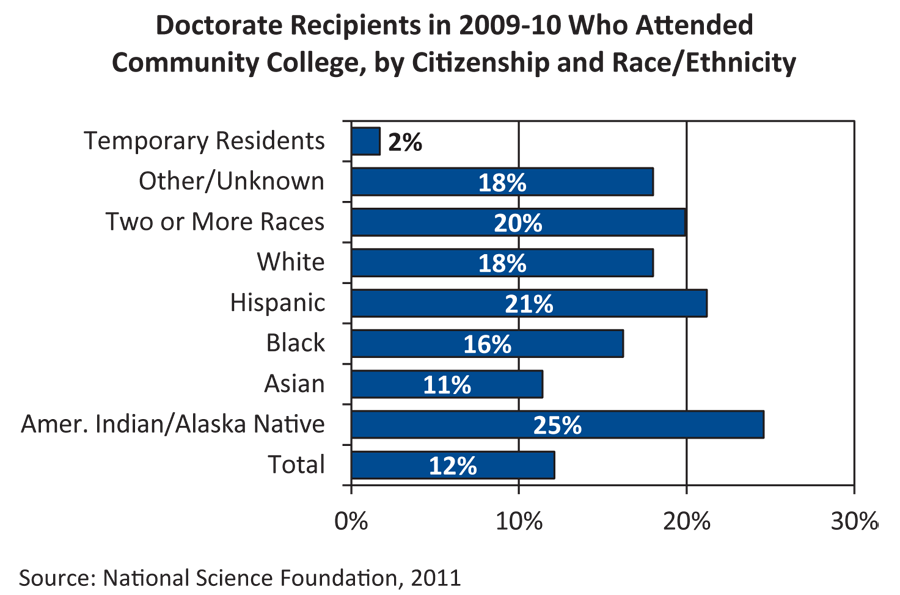
Individuals who earned a doctorate in education were most likely to have earned college credit from a community or two-year college (see Figure 2). One out of five doctorate recipients in education in 2009–10 had attended a two-year college at some point, along with 14% of those in social sciences, and 13% of those in both humanities and life sciences. Engineering doctorate recipients were least likely to have attended a community college, with just 7% reporting having done so.
Figure 2

Community college attendance is even more prevalent among recent master’s degree recipients. Among individuals who earned master’s degrees in science, engineering, or health fields in academic years 2002–03, 2003–04, and 2004–05 (the most recent data available), 41% had taken at least one course at a community college at some point (National Science Foundation, 2010). As shown in Figure 3, master’s degree recipients in health fields were most likely to have taken a course at a two-year college (57%), and master’s degree recipients in mathematics and statistics were least likely to have done so (23%).
Figure 3
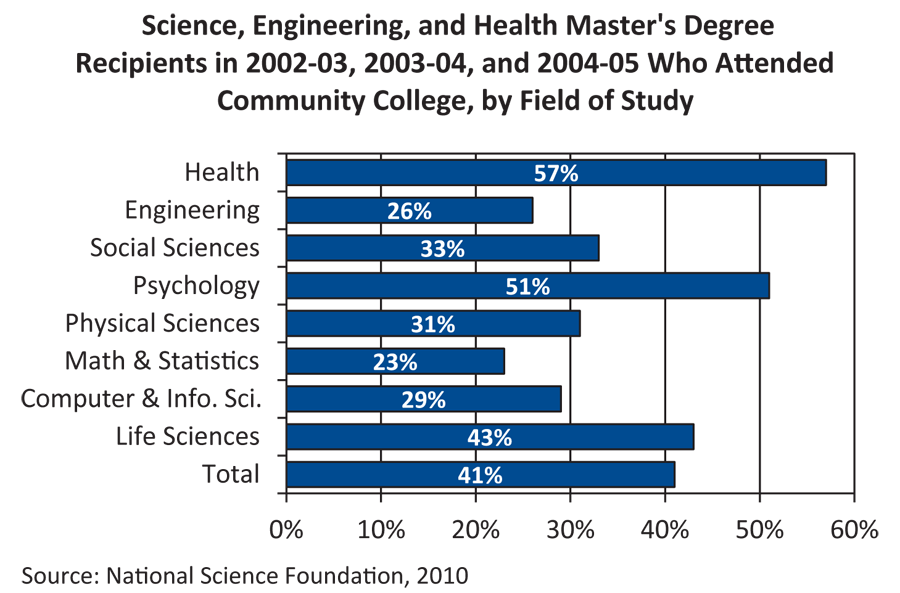
The findings are similar among recent bachelor’s degree recipients. Half (50%) of the individuals who earned bachelor’s degrees in science, engineering, or health fields in academic years 2002–03, 2003–04, and 2004–05 had attended a community college at some point (National Science Foundation, 2010). Bachelor’s degree recipients in health fields were again most likely to have taken a course at a two-year college (67%), while bachelor’s recipients in mathematics and statistics were again least likely to have done so (42%).
The data clearly show that many students who attend two-year colleges will eventually go on to earn bachelor’s degrees, master’s degrees, and doctorates. Getting more of the students who attend two-year institutions to go on to earn advanced degrees could help diversify the graduate student population. With higher percentages of underrepresented minorities, low socioeconomic status students, and first generation college students attending two-year institutions than four-year institutions, community colleges are an important source of tomorrow’s graduate students.
By Nathan E. Bell, Director, Research and Policy Analysis, Council of Graduate Schools
References:
National Center for Education Statistics. (2011). Community College Student Outcomes: 1994-2009. Retrieved from http://nces.ed.gov/pubs2012/2012253.pdf.
National Science Foundation. (2010). Characteristics of Recent Science and Engineering Graduates: 2006. Retrieved from http://www.nsf.gov/statistics/nsf10318/.National Science Foundation. (2011).
Doctorate Recipients from U.S. Universities: 2010. Retrieved from http://www.nsf.gov/statistics/sed/start.cfm.
Provasnik, S., and Planty, M. (2008).
Community Colleges: Special Supplement to The Condition of Education 2008. National Center for Education Statistics, Institute of Education Sciences, US Department of Education: Washington, DC.
Snyder, T.D., and Dillow, S.A. (2011). Digest of Education Statistics, 2010. National Center for Education Statistics, Institute of Education Sciences, US Department of Education: Washington, DC.




